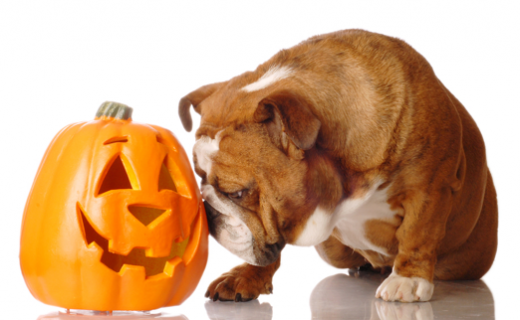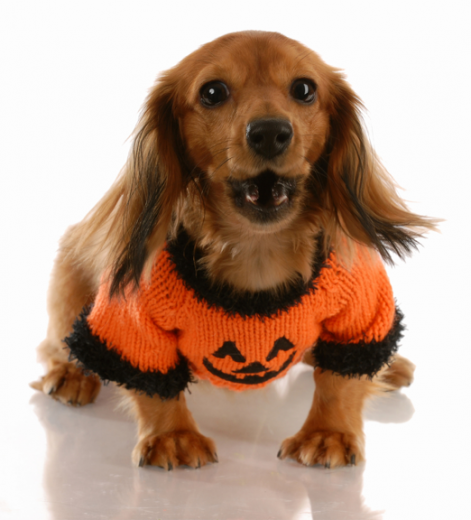This article was originally featured on Woman Around Town on Tuesday, Nov. 22nd, 2011
Holiday celebrations bring together good food, beautiful decorations, fabulous parties, and welcome guests. Keeping your pets safe and happy during these gatherings means coming up with a game plan beforehand and making sure visitors are on board. While dogs and cats may gladly eat any tidbits tossed their way, human food can be harmful, even dangerous, for your pet to ingest. Twinkling lights, flickering candles, and glittering ornaments create a festive atmosphere but may mean a trip to the animal hospital’s emergency room. You may describe your pet as “people friendly,” but when faced with a crowd and loud noises, even the best behaved dog or cat may become unpredictable.
So keep your holiday events safe and your pets happy by checking out the following tips.
 Food
Food
Your guests may rave about your dinner, but please tell them to resist feeding your dog or cat. Holiday foods are usually high in fat and, for a cat or dog, can cause gastric distress including inappetance, vomiting and diarrhea, and even pancreatitis (inflammation of the pancreas). Some specifics:
Turkey bones can splinter and, if swallowed, cause tears in the esophagus and the stomach.
Watch the nuts! Macadamia nuts, in particular, can be toxic to dogs.
Also keep your pet away from grapes and raisins. (Sorry, you can’t feed your Aunt Ethel’s fruit cake to the dog).
Chocolate contains an ingredient—theobromine—that can make your animal very sick. The darker the chocolate, the higher the risk. Milk chocolate is not as dangerous, but is still toxic. So no sweets for your sweetie!
Yeast dough for those pies and biscuits can cause bloating in animals. Watch pets during food preparation to make sure anything that falls on the floor doesn’t end up in their stomaches.
Candy and gum containing Xylitol can be toxic to your pet and cause a sudden drop in blood sugar, lack of coordination, and, possibly, a seizure. Never place bowls of candy on low tables.
 Flowers and Plants
Flowers and Plants
Fragrant blooms and green stems add color to your party. But certain ones can be poisonous to your pet.
Lillies produce a chemical that can produce kidney failure in your cat.
Mistletoe may be a good place to invite a kiss, but it also invites trouble for your kitty or doggy. So opt for the artificial kind. (The mistletoe, not the kiss!)
Poinsettas are lower in toxicity, but if your dog or cat chews on the leaves or flowers, you may see vomiting and diarrhea.
Evergreen trees are not, in themselves, poisonous, but if needles are swallowed, the result may be a gastrointestinal upset. Watch that your cat or dog does not drink out of the tree’s water pan where bacteria may be growing. Sometimes trees have been fertilized, and drinking the tree’s water can make your pet very ill.
Holly–the leaves and the berries—are mildly toxic to pets. Deck the halls with something else. That brings up….
 Decorations
Decorations
When outfitting your tree, place breakable items higher up. If you opt for tinsel, keep those silver icicles on top, too.
Tuck electrical cords where they cannot be chewed. Protective covers for electrical cords may be purchased at hardware stores.
Candles for Hanukkah should be kept away from pets. Same for Christmas candles.
Ribbons, strings, and wrapping paper, if ingested by your pet, will most certainly lead to trouble. Christmas morning, take out a large garbage bag to quickly dispose of all those wrappings.
Visitors
Know your pet. What makes your pet uncomfortable? If lots of strangers milling about your house creates a hostile environment for your pet, remove your cat or dog to a room away from the crowds.
Watch children. Even the best behaved dog may react negatively to pulling and poking by a small child.
Talk to your guests. Make sure your visitors know not to approach your pets without you present and understand your rule about feeding table food.
Routine
Animals like routine. Even if you have guests, make sure that your pets are fed and exercised on schedule.
If you are the visitor rather than the host, ask whether your pets will be welcome. If not, make arrangements to board your pets or hire a pet sitter.
Symptoms that your animals may be sick include vomiting, diarrhea, hyperactivity, and pacing. Keep emergency numbers handy. The ASPCA Poison Control Center website has a list of toxic and non toxic plants. If you have questions, call the center at 888-426-4435 for a $65 consultation fee.
Here are some other sources for your reference:
In New York:
Blue Pearl (formerly know as New York City Veterinary Specialists) branches in Manhattan, Queens, and Brooklyn
Manhattan
The Animal Medical Center
Fifth Avenue Veterinary Specialist
Brooklyn
Veterinary Emergency and Referral Group
In Washington DC
DC Metro Vet
Fairfax
South Paws Veterinary Specialists and Emergency Center
 Halloween is a time for ghosts and goblins, witches and skeletons, trick or treat, parties, and visitors. Make sure that you keep your pets safe during the October 31st festivities. Here are a few tips:
Halloween is a time for ghosts and goblins, witches and skeletons, trick or treat, parties, and visitors. Make sure that you keep your pets safe during the October 31st festivities. Here are a few tips:




